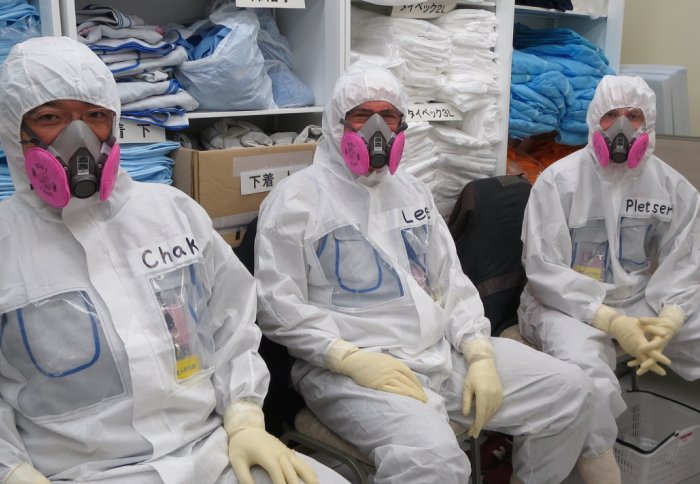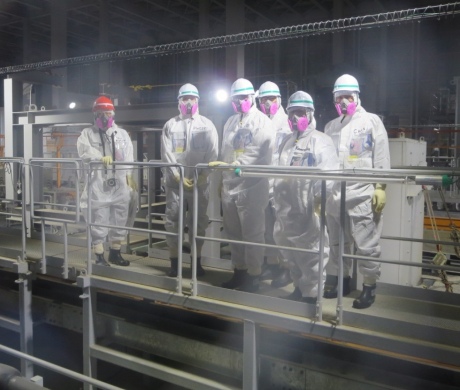Imperial researcher reflects on his visit to Fukushima on anniversary
by Colin Smith

Professor Bill Lee (middle) and PhD student Dimitri Pletser (right)
An Imperial nuclear expert describes his visit last year to the Fukushima Daiichi Nuclear Reactor Power Plant, five years on from the crisis.
In March 2011, an earthquake off the east coast of Japan triggered a tsunami, which crashed into the Fukushima Daiichi Nuclear Plant. This led to explosions and a partial meltdown of three boiling water reactors and the mass evacuation by authorities of citizens living in the surrounding area.

Professor Lee, Dimitri Plester and other researchers tour a facility, which processes cooling liquids at the plant.
In March 2015, Professor Bill Lee, Director of the Centre for Nuclear Engineering at Imperial, and PhD student Dimitri Pletser, also from the Centre, visited the clean-up operations. Since the accident, water has been used to cool the damaged cores. The site visit was part of Professor Lee’s and Dr Plester’s research to develop ways of capturing and disposing of radioactive waste collected from the cooling water.
Colin Smith caught up with Professor Lee who shared what it was like to be in a disaster zone. He put into context the clean-up operation, which is complex, mammoth and often dangerous for engineers.
Can you describe what it is like to be in that environment?
Seeing the devastation that the tsunami wrought on the both the reactor site and also the 20 km exclusion zone around the plant was a humbling experience. I’ll never forget it.
At the plant, it is very difficult to fully appreciate the scale of the whole clean-up, until you witness it first-hand. TV news programmes, photographs and satellite imagery just don’t do it justice.
When we visited, the reactor buildings were vast masses of tangled metal and concrete. Since then I know most of that wreckage has gone and temporary weatherproof structures have been placed over the damaged reactor buildings.
The entire site now houses the facilities for the clean-up operation including filter systems to strip radionuclides from the water, which is used to cool the reactor cores.
There is an operations command centre, where the clean-up is managed and a huge incinerator has been installed to burn all contaminated clothing worn by the workers each day.
Can you paint a picture of the scale of the clean-up operation?
The workforce alone is huge. There are roughly 7000 people working on-site every day to help redress it. They are working in often very difficult or hazardous conditions, making the progress achieved so far all the more impressive.
The clean-up covers a very wide radius where workers are stripping off top soil, cutting back growth of contaminated vegetation and storing contaminated materials.
Much of the current clean-up is geared towards developing new technologies for examining inside the damaged reactors using robots.
Teams are also examining how to stop water leaks from the damaged pressure vessels and developing techniques for remotely retrieving the radioactive material inside the reactor cores.
They are on constant alert for changes in reactor conditions, assessing them using severe accident analysis codes.
There also are teams putting together mid and long-term road maps for decommissioning reactor units, which will last for the next 40 years!
What are some of the complexities of the situation?
Units one to three are currently being decommissioned, which is expected to continue until 2050. It is taking longer to clean these up because the radiation levels are still very high.
Huge metal structures that are 60 metres tall are being constructed, which will be placed over units one to three, like the one that is on unit four. This will enable easy access from the top of the reactor into the cores to remove the fuel debris, which is the most radioactive material. However, since each reactor is damaged differently these structures need to be bespoke in their design, which adds another level of complexity to the construction process.
How is the community coping with the situation?
One of the big challenges faced by authorities is managing the concerns and perceptions of the community while making informed decisions about the clean-up.
The radioactive decay occurring in the reactor cores of the three damaged units is generating a lot of heat, which needs to be constantly cooled with water. However, the site is slowly running out of space to store the treated water. It is currently not possible to release it into the ocean in a controlled, safe way due to political pressures exerted by the local union of fishermen who fear possible contamination of fish stock.
To put it into context storing increasing quantities of tritiated water has meant that woodland on the site has had to be cleared. However, this has led to run-off contamination, which has gone into the sea. Also, there is concern that plans to build and expensive frozen earth barrier around the entire site to contain waste from entering the ocean may not be effective.
In our personal opinion after a suitable storage period a controlled release of the tritiated water into the sea is a sensible long-term solution. Tritium’s half-life is short - only 12.33 years and a controlled release would have little impact on the environment.
In light of moves to build more reactors in this country, what engineering lessons can the UK learn from this disaster?
It must be remembered that Fukushima was, according to the Japanese Parliament Review, an “accident made in Japan”. It should never have happened and had Japan followed the same approach to the regulation of its nuclear industry as is done in the UK none of the reactors would have been significantly damaged.
A major lesson we can take home from this disaster is the value of not becoming complacent about safety. Policymakers and engineers relied on past earthquake and tsunami data to design and construct their flood defences and sea walls, which they thought could withstand any known impacts from the sea.
Hindsight has taught us the very valuable the lesson of expecting things that were originally considered beyond-design-basis to be entirely possible.
Article text (excluding photos or graphics) © Imperial College London.
Photos and graphics subject to third party copyright used with permission or © Imperial College London.
Reporter
Colin Smith
Communications and Public Affairs